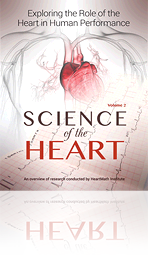Energetic Communication
The first biomagnetic signal was demonstrated in 1863 by Gerhard Baule and Richard McFee in a magnetocardiogram (MCG) that used magnetic induction coils to detect fields generated by the human heart.[203] A remarkable increase in the sensitivity of biomagnetic measurements has since been achieved with the introduction of the superconducting quantum interference device (SQUID) in the early 1970s. The ECG and MCG signals have since been shown to closely parallel one another.[204]
In this section, we discuss how the magnetic fields produced by the heart are involved in energetic communication, which we also refer to as cardioelectromagnetic communication. The heart is the most powerful source of electromagnetic energy in the human body, producing the largest rhythmic electromagnetic field of any of the body’s organs. The heart’s electrical field is about 60 times greater in amplitude than the electrical activity generated by the brain. This field, measured in the form of an electrocardiogram (ECG), can be detected anywhere on the surface of the body. Furthermore, the magnetic field produced by the heart is more than 100 times greater in strength than the field generated by the brain and can be detected up to 3 feet away from the body, in all directions, using SQUID-based magnetometers (Figure 6.1).
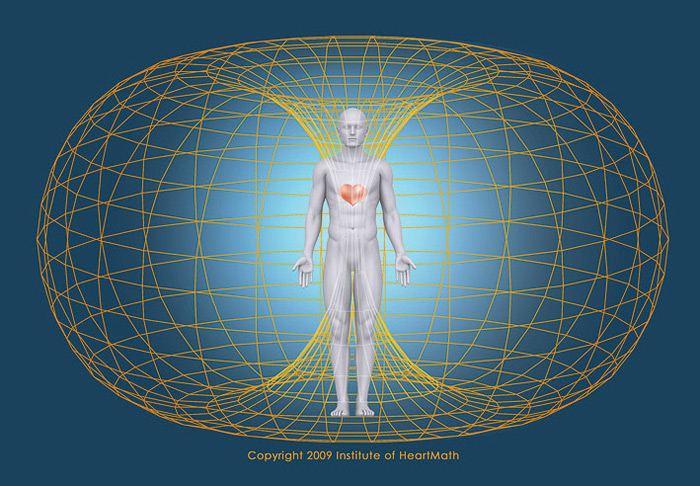
Figure 6.1 The heart’s magnetic field, which is the strongest rhythmic field produced by the human body, not only envelops every cell of the body, but also extends out in all directions into the space around us. The heart’s magnetic field can be measured several feet away from the body by sensitive magnetometers. Research conducted at HMI suggests the heart’s field is an important carrier of information.
Prompted by our findings that the timing between pulses of the heart’s magnetic field is modulated by different emotional states, we have performed several studies that show the magnetic signals generated by the heart have the capacity to affect individuals around us.
Biological Encoding of Information
Every cell in our bodies is bathed in an external and internal environment of fluctuating invisible magnetic forces.[205] It has become increasingly apparent that fluctuations in magnetic fields can affect virtually every circuit in biological systems to a greater or lesser degree, depending on the particular biological system and the properties of the magnetic fluctuations.[5, 205] One of the primary ways that signals and messages are encoded and transmitted in physiological systems is in the language of patterns. In the nervous system it is well established that information is encoded in the time intervals between action potentials, or patterns of electrical activity.[206] This also applies to humoral communications in which biologically relevant information also is encoded in the time interval between hormonal pulses.[207-209] As the heart secretes a number of different hormones with each contraction, there is a hormonal pulse pattern that correlates with heart rhythms. In addition to the encoding of information in the space between nerve impulses and in the intervals between hormonal pulses, it is likely that information also is encoded in the interbeat intervals of the pressure and electromagnetic waves produced by the heart. This supports Pribram’s proposal discussed earlier that low-frequency oscillations generated by the heart and body in the form of afferent neural, hormonal and electrical patterns are the carriers of emotional information and the higher frequency oscillations found in the EEG reflect the conscious perception and labeling of feelings and emotions.[169] We have proposed that these same rhythmic patterns also can transmit emotional information via the electromagnetic field into the environment, which can be detected by others and processed in the same manner as internally generated signals.
Heartbeat-Evoked Potentials
A useful technique for detecting synchronized activity between systems in biological systems and investigating a number of bioelectromagnetic phenomena is signal averaging. This is accomplished by superimposing any number of equal-length epochs, each of which contains a repeating periodic signal. This emphasizes and distinguishes any signal that is time-locked to the periodic signal while eliminating variations that are not time-locked to the periodic signal. This procedure is commonly used to detect and record cerebral cortical responses to sensory stimulation [210]. When signal averaging is used to detect activity in the EEG that is time-locked to the ECG, the resultant waveform is called the heartbeat-evoked potential.
The heart generates a pressure wave that travels rapidly throughout the arteries, much faster than the actual flow of blood that we feel as our pulse. These pressure waves force the blood cells through the capillaries to provide oxygen and nutrients to cells and expand the arteries, causing them to generate a relatively large electrical voltage. These pressure waves also apply pressure to the cells in a rhythmic fashion that can cause some of their proteins to generate an electrical current in response to this "squeeze." Experiments conducted in our laboratory have shown that a change in the brain’s electrical activity can be seen when the blood-pressure wave reaches the brain around 240 milliseconds after systole.
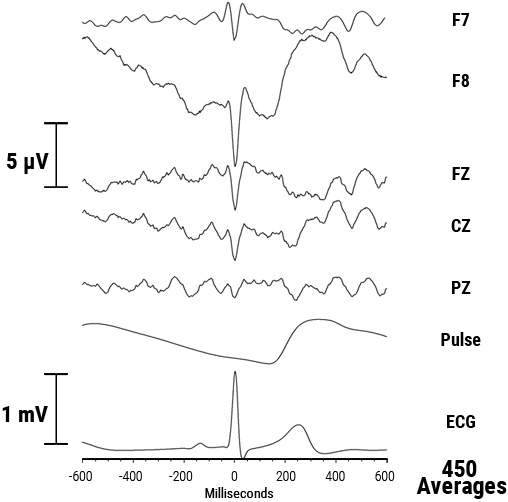
Figure 6.2 Heartbeat-evoked potentials. This figure shows an example of typical heartbeat-evoked potentials. In this example, 450 averages were used. The pulse wave also is shown, indicating the timing relationship of the blood-pressure wave reaching the brain. In this example, there is less synchronized alpha activity immediately after the R-wave. The time range between 10 and 240 milliseconds is when afferent signals from the heart are impinging upon the brain and the alpha desynchronization indicates the processing of this information. Increased alpha activity can be seen later in the waveforms, starting at around the time the blood-pressure wave reaches the brain.
There is a replicable and complex distribution of heartbeat-evoked potentials across the scalp. Changes in these evoked potentials associated with the heart’s afferent neurological input to the brain are detectable between 50 to 550 milliseconds after the heartbeat.[8] Gary Schwartz and his colleagues at the University of Arizona believe the earlier components in this complex distribution cannot be explained by simple physiological mechanisms alone and suggest that an energetic interaction between the heart and brain also occurs.[211] They have confirmed our findings that heart-focused attention is associated with increased heart-brain synchrony, providing further support for energetic heart-brain communications.[5] Schwartz and his colleagues also demonstrated that when subjects focused their attention on the perception of their heartbeat, the synchrony in the preventricular region of the heartbeat-evoked potential increased. They concluded that this synchrony may reflect an energetic mechanism of heart-brain communication, while post-ventricular synchrony most likely reflects direct physiological mechanisms.
Biomagnetic Communication Between People
We have found there is a direct relationship between the heart-rhythm patterns and the spectral information encoded in the frequency spectra of the magnetic field radiated by the heart. Thus, information about a person’s emotional state is encoded in the heart’s magnetic field and is communicated throughout the body and into the external environment.
Figure 6.3 shows two different power spectra derived from an average of 12 individual 10-second epochs of ECG data recorded during differing psychophysiological modes. The plot on the left was produced while the subject was in a state of deep appreciation, whereas the plot on the right was generated while the subject experienced recalled feelings of anger. The difference in the patterns and thus the information they contain, can be seen clearly. There is a direct correlation between the patterns in the heart rate variability rhythm and the frequency patterns in the spectrum of the ECG or MCG. Experiments such as these indicate that psychophysiological information can be encoded into the electromagnetic fields produced by the heart.[163, 212]
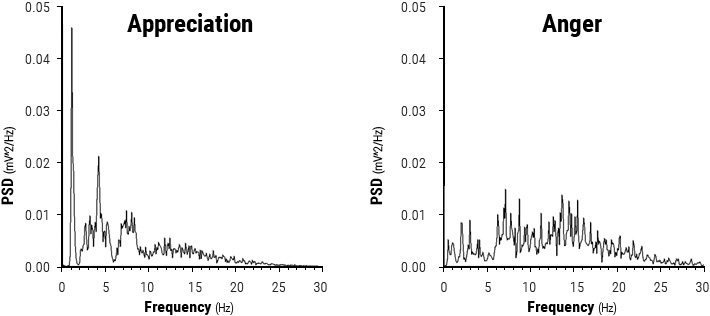
Figure 6.3 ECG spectra during different emotional states. The above graphs are the average power spectra of 12 individual 10-second epochs of ECG data, which reflect information patterns contained in the electromagnetic field radiated by the heart. The left-hand graph is an example of a spectrum obtained during a period of high heart-rhythm coherence generated during a sustained heartfelt experience of appreciation. The graph on the right depicts a spectrum associated with a disordered heart rhythm generated during feelings of anger.
The human body is replete with mechanisms for detecting its external environment. Sense organs, the most obvious example, are specifically geared to react to touch, temperature, select ranges of light, sound waves, etc. These organs are acutely sensitive to external stimuli. The nose, for example, can detect one molecule of gas, while a cell in the retina of the eye can detect a single photon of light. If the ear were any more sensitive, it would pick up the sound of the random vibrations of its own molecules.[213]
The interaction between two human beings, such as, the consultation between patient and clinician or a discussion between friends, is a very sophisticated dance that involves many subtle factors. Most people tend to think of communication solely in terms of overt signals expressed through facial movements, voice qualities, gestures and body movements. However, evidence now supports the perspective that a subtle yet influential electromagnetic or "energetic" communication system operates just below our conscious level of awareness. The following section will discuss data that suggests this energetic system contributes to the "magnetic" attractions or repulsions that occur between individuals.
The ability to sense what other people are feeling is an important factor in allowing us to connect, or communicate effectively with them. The smoothness or flow in any social interaction depends to a great extent on the establishment of a spontaneous entrainment or linkage between individuals. When people are engaged in deep conversation, they begin to fall into a subtle dance, synchronizing their movements and postures, vocal pitch, speaking rates and length of pauses between responses,[214] and, as we are now discovering, important aspects of their physiology also can become linked and synchronized.
The Electricity of Touch: Detection and Measurement of Cardiac Energy Exchange Between People
An important step in testing our hypothesis that the heart’s electromagnetic field could transmit signals between people was to determine if an individual’s field and the information modulated within it could be detected by others. In conducting these experiments, the question being asked was straightforward: Can the electromagnetic field generated by the heart of one individual be detected in physiologically relevant ways in another person, and if so, does it have any discernible biological effects? To investigate these possibilities, we used signal-averaging techniques to detect signals that were synchronous with the peak of the R-wave of one subject’s ECG in recordings of another subject’s electroencephalogram (EEG) or brain waves. My colleagues and I have performed numerous experiments in our laboratory over several years using these techniques.[215] Several examples are included below to illustrate some of our findings. In the majority of these experiments, subjects were seated in comfortable, high-back chairs to minimize postural changes with the positive ECG electrode located on the side at the left sixth rib and referenced to the right supraclavicular fossa, according to the International 10-20 system. The ECG and EEG were recorded for both subjects simultaneously so the data (typically sampled at 256 hertz or higher) could be analyzed for simultaneous signal detection in both (Figure 6.4).
To clarify the direction in which the signal flow was analyzed, the subject whose ECG R-wave was used as the time reference for the signal-averaging procedure is referred to as the "signal source," or simply "source." The subject whose EEG was analyzed for the registration of the source’s ECG signal is referred to as the "signal receiver," or simply "receiver." The number of averages used in the majority of the experiments was 250 ECG cycles (~4 minutes). The subjects did not consciously intend to send or receive a signal and, in most cases, were unaware of the true purpose of the experiments. The results of these experiments have led us to conclude that the nervous system acts as an antenna, which is tuned to and responds to the magnetic fields produced by the hearts of other individuals. My colleagues and I call this energetic information exchange energetic communication and believe it to be an innate ability that heightens awareness and mediates important aspects of true empathy and sensitivity to others. Furthermore, we have observed that this energetic communication ability can be enhanced, resulting in a much deeper level of nonverbal communication, understanding and connection between people. We also propose that this type of energetic communication between individuals may play a role in therapeutic interactions between clinicians and patients that has the potential to promote the healing process.
From an electrophysiological perspective, it appears that sensitivity to this form of energetic communication between individuals is related to the ability to be emotionally and physiologically coherent. The data indicate that when individuals are in the coherent state, they are more sensitive to receiving information contained in the magnetic fields generated by others. In addition, during physiological coherence, internal systems are more stable, function more efficiently and radiate electromagnetic fields containing a more coherent structure.[163]
The first step was to determine if the ECG signal of one person could be detected in another individual’s EEG during physical contact. For these experiments, we seated pairs of subjects 4 feet apart and monitored them simultaneously.
Although in most pairs a clear signal transfer between the two subjects was measurable in one direction, it was only observed in both directions simultaneously in about 30 percent of the pairs (i.e., Subject 2’s ECG could be detected in Subject 1’s EEG at the same time Subject 1’s ECG was detectable in Subject 2’s EEG). As shown later, an important variable appears to be the degree of physiological coherence maintained. After demonstrating that the heart’s activity could be detected in another’s EEG during physical contact, we completed a series of experiments to determine if the signal was transferred via electrical conduction alone or if it also was energetically transferred via magnetic fields. The results suggest a significant degree of signal transfer occurs through skin conduction, but it also is radiated between individuals, which will be discussed next.
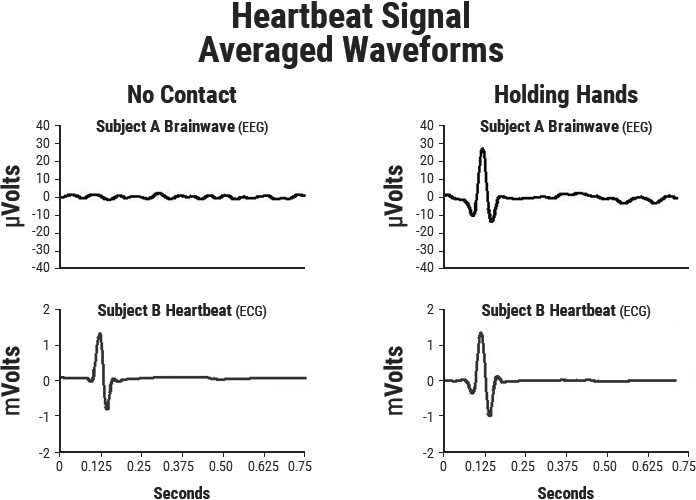
Figure 6.4 Heartbeat signal-averaged waveforms showing a transference of the electrical energy generated by Subject B’s heart can be detected in Subject A’s EEG (brain waves) when they hold hands.
Heart-Brain Synchronization During Nonphysical Contact
Because the magnetic component of the field produced by the heartbeat naturally radiates outside the body and can be detected several feet away with SQUID-based magnetometers,[217] we decided to further test the transference of signals between subjects who were not in physical contact. In these experiments, the subjects either were seated side by side or facing each other at varying distances. In some cases, we were able to detect a clear QRS-shaped signal in the receiver’s EEG. Although the ability to obtain a clear registration of the ECG in the other person’s EEG declined as the distance between subjects was increased, the phenomenon appears to be nonlinear. For instance, a clear signal could be detected at a distance of 18 inches in one session, but was undetectable in the very next trial at a distance of only 6 inches. Although transmission of a clear QRS-shaped signal is uncommon at distances over 6 inches in our experience, physiologically relevant information is communicated between people at much further distances and is reflected in synchronized activity.
Figure 6.5 shows the data from two subjects seated and facing one another at a distance of 5 feet, with no physical contact. They were asked to use the Heart Lock-In Technique,[179] which has been shown to produce sustained states of physiological coherence.[116] Participants were not aware of the purpose of the experiment. The top three traces show the signalaveraged waveforms derived from the EEG locations along the medial line of the head.
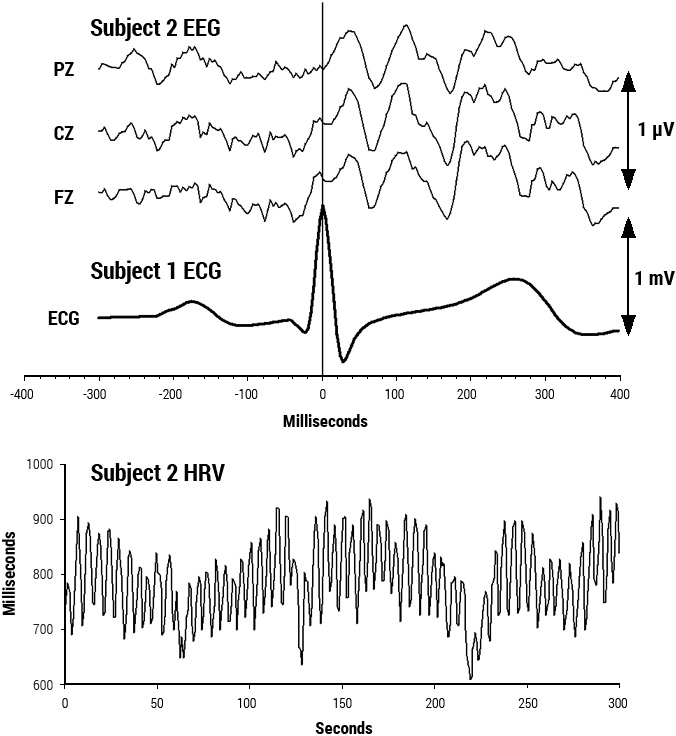
Figure 6.5 Heart-brain synchronization between two people. The top three traces are Subject 2’s signal-averaged EEG waveforms, which are synchronized to the R-wave of Subject 1’s ECG. The lower plot shows Subject 2’s heart rate variability pattern, which was coherent throughout the majority of the record. The two subjects were seated at a conversational distance without physical contact.
Note that in this example the signal-averaged waveforms do not contain any semblance of the QRS complex shape as seen in the physical contact experiments. Rather, they reveal the occurrence of an alpha-wave synchronization in the EEG of one subject that is precisely timed to the R-wave of the other subject’s ECG.
Power-spectrum analysis of the signal-averaged EEG waveforms showed that the alpha rhythm was synchronized to the other person’s heart. This alpha synchronization does not imply that there is increased alpha activity, but it does show that the existing alpha rhythm is able to synchronize to extremely weak external electromagnetic fields such as those produced by another person’s heart. It is well known that the alpha rhythm can synchronize to an external stimulus such as sound or light flashes, but the ability to synchronize to such a subtle electromagnetic signal is surprising. As mentioned, there also is a significant ratio of alpha activity that is synchronized to one’s own heartbeat and the amount of this synchronized alpha activity is significantly increased during periods of physiological coherence.[5, 219]
Figure 6.6 shows an overlay plot of one of Subject 2’s signal-averaged EEG traces and Subject 1’s signalaveraged ECG.
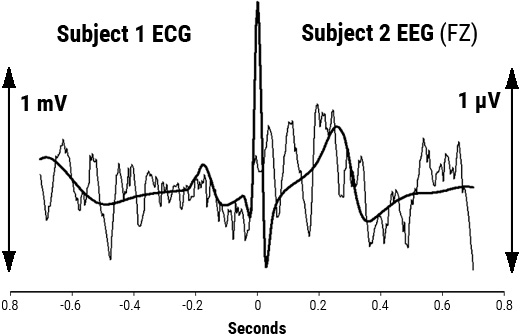
Figure 6.6 Overlay of signal-averaged EEG and ECG. This graph is an overlay plot of the same EEG and ECG data shown in Figure 6.5. Note the similarity of the wave shapes, indicating a high degree of synchronization.
This view shows an amazing degree of synchronization between the EEG of Subject 2 and Subject 1’s heart. These data show it is possible for the magnetic signals radiated by the heart of one individual to influence the brain rhythms of another. In addition, this phenomenon can occur at conversational distances.
Energetic Sensitivity and Empathy
Figure 6.7 shows the data from the same two subjects during the same time period, but it is analyzed for alpha synchronization in the opposite direction (Subject 1’s EEG and Subject 2’s ECG). In this case, we see that there is no observable synchronization between Subject 1’s EEG and Subject 2’s ECG. The key difference between the data shown in figures 6.5 and 6.6 is the high degree of physiological coherence maintained by Subject 2. In other words, the degree of coherence in the receiver’s heart rhythms appears to determine whether his/her brain waves synchronize to the other person’s heart.
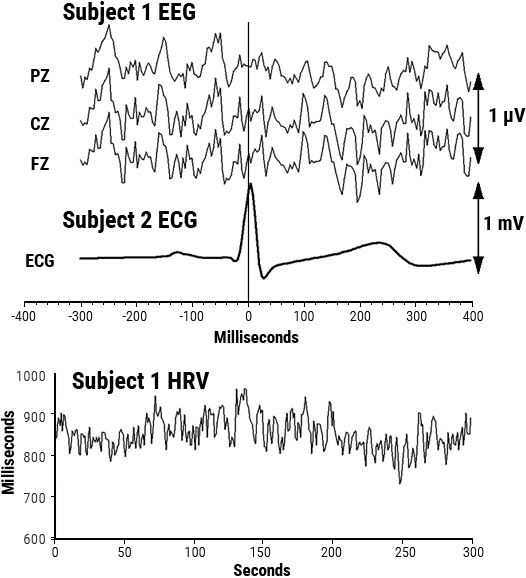
Figure 6.7 The top three traces are the signal-averaged EEG waveforms for Subject 1. There is no apparent synchronization of Subject 1’s alpha rhythm to Subject 2’s ECG. The bottom plot is a sample of Subject 1’s heart rate variability pattern, which was incoherent throughout the majority of the record.
This suggests that when a person is in a physiologically coherent state, he or she exhibits greater sensitivity in registering the electromagnetic signals and information patterns encoded in the fields radiated by others’ hearts. At first glance the data may be interpreted to mean we are more vulnerable to the potential negative influence of incoherent patterns radiated by those around us. In fact, the opposite is true. When people are able to maintain the physiological coherence mode, they are more internally stable and thus less vulnerable to being negatively affected by the fields emanating from others. It appears that increased internal stability and coherence is what allows the increased sensitivity to emerge.
This fits quite well with our experience in training thousands of individuals how to self-generate and maintain coherence while they are communicating with others. Once individuals learn this skill, it is a common experience that they become much more attuned to other people and are able to detect and understand the deeper meaning behind spoken words. They often are able to sense what someone else truly wishes to communicate even when the other person may not be clear in what he or she is attempting to say. The Coherent Communication Technique helps people to feel fully heard, speak authentically and with discernment and promote greater rapport and empathy between people.[180]
Heart-Rhythm Synchronization Between People
When heart rhythms are more coherent, the electromagnetic field that is radiated outside the body correspondingly becomes more organized, as shown in Figure 6.3. The data presented thus far indicate that signals and information can be communicated energetically between individuals and that they have measurable biological effects, but so far have not implied a literal synchronization of two individuals’ heart-rhythm patterns. We have found that synchronization of heart-rhythm patterns between individuals is possible, but usually occurs only under specific conditions. In our experience, true heart-rhythm synchronization between individuals is rare during normal waking states. We have found that individuals who have a close working or living relationship are the best candidates for exhibiting true heart-rhythm synchronization. Figure 6.8 shows an example of heart-rhythm synchronization between two women who have a close working relationship and practice coherencebuilding techniques regularly. For this experiment, they were seated 4 feet apart and were consciously focused on generating feelings of appreciation for each other.
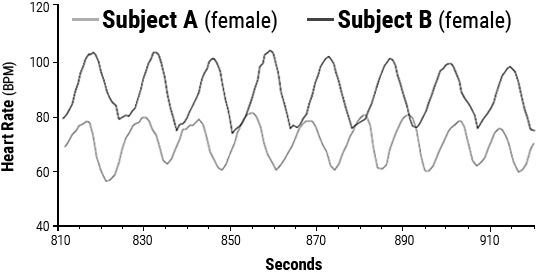
Figure 6.8 Heart-rhythm entrainment between two people. These data were recorded while both subjects were practicing the Heart Lock-In Technique and consciously feeling appreciation for each other.
A more complex type of synchronization also can occur during sleep. Although we have only looked at couples who are in long-term stable and loving relationships, we have been surprised at the high degree of heart-rhythm synchrony observed in these couples while they sleep. Figure 6.9 shows an example of a small segment of data from one couple.
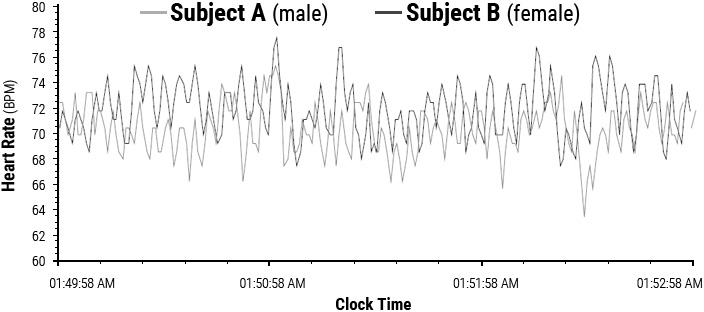
Figure 6.9 Heart-rhythm entrainment between husband and wife during sleep.
These data were recorded using an ambulatory ECG recorder with a modified cable harness that allowed the concurrent recording of two individuals on the same recording. Note how the heart rhythms simultaneously change in the same direction and how heart rates converge. Throughout the recording, clear transition periods are evident in which the heart rhythms move into greater synchronicity for some time and then drift out again. This implies that unlike in most wakeful states, synchronization between the heart rhythms of individuals can and does occur during sleep.
Another line of research that has shown physiological synchronization between people was in a study of a 30-minute Spanish firewalking ritual. Heart-rate data was obtained from 38 participants and synchronized activity was compared between firewalkers and spectators. They showed fine-grained commonalities of arousal during the ritual between firewalkers and related spectators but not unrelated spectators. The authors concluded that their findings demonstrated that a collective ritual can evoke synchronized arousal over time between active participants and relatives or close friends. They also suggest that the study links field observations to a physiological basis and offers a unique approach for the quantification of social effects on human physiology during real-world interactions, a mediating mechanism that is likely informational.[220]
Morris[221] studied the effect of heart coherence in a group setting with participants who were trained in HeartMath’s Quick Coherence® Technique. He conducted 148 10-minute trials in which three trained participants were seated around a table with one untrained participant. During each trial, three of the trained participants were placed with untrained volunteers to determine whether the three could collectively facilitate higher levels of HRV coherence in the untrained individual. The coherence of the HRV of the untrained subject was found to be higher in approximately half of all matched comparisons when the trained participants focused on achieving increased coherence. In addition, evidence of heartrhythm synchronization between group participants was revealed through several evaluation methods and higher levels of coherence correlated to higher levels of synchronization between participants. There was a statistical relationship between this synchronization and relational measures (bonding) among the participants. The authors concluded that "evidence of heart-to-heart synchronization across subjects was found, lending credence to the possibility of heart-toheart biocommunications."
Using signal-averaging techniques, we also were able to detect synchronization between a mother’s brain waves (EEG-CZ) and her baby’s heartbeats (ECG). The pair were not in physical contact, but when the mother focused her attention on the baby, her brain waves synchronized to the baby’s heartbeats (Figure 6.10). We were not able to detect that the infant’s EEG synchronized to the mother’s heartbeats.
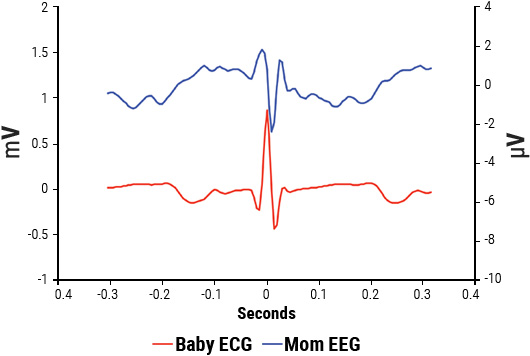
Figure 6.10 ECG and EEG synchronization between mother and baby.
Biomagnetic Communication Between People and Animals
Farmers and attentive observers know that most cattle and sheep, when grazing, face the same way. It has been demonstrated by means of satellite images, field observations and measurements of deer beds in snow that domestic cattle across the globe and grazing and resting red and roe deer align their body axes in roughly a north-south direction and orient their heads northward when grazing or resting. Wind and light conditions were excluded as common determining factors, so magnetic alignment with the earth’s geomagnetic field was determined to be the best explanation. Magnetic north was a better predictor than geographic north, suggesting large mammals have magnetoreception capability.[222]
We also have found that a type of heart-rhythm synchronization can occur in interactions between people and their pets. Figure 6.11 shows the results of an experiment looking at the heart rhythms of my son, Josh (age 12 at the time of the recording) and his dog, Mabel. Here we used two Holter recorders, one fitted on Mabel and the other on Josh. We synchronized the recorders and placed Mabel in one of our labs.
Josh entered the room and sat down and proceeded to do a Heart Lock-In and consciously radiate feelings of love toward Mabel. There was no physical contact and he did not make any attempts to get the dog’s attention. In Figure 6.11, note the synchronous shift to increased coherence in the heart rhythms of both Josh and Mabel as Josh consciously feels love for his pet.
Another example of an animal’s heart-rhythm pattern shifting in response to a human’s shift of emotional states is shown in Figure 6.12. This was a collaborative study with Ellen Gehrke, Ph.D. who consciously shifted into a coherent state while sitting in a corral with her horse, neither touching nor petting it. When she shifted into a coherent state, the horse’s heartrhythm pattern also shifted to a more ordered pattern.
In other trials, very similar shifts in horses’ HRV patterns were seen in three out of four horses’ heart rhythms. One of the horses that did not show any response was well known for not relating well to humans or other horses.
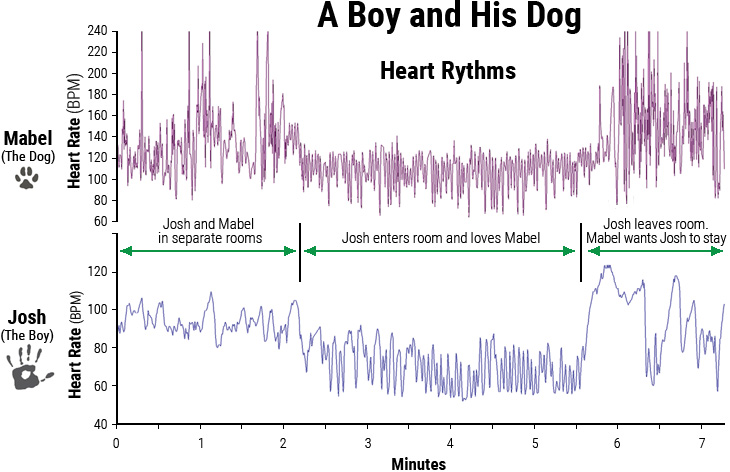
Figure 6.11 Heart-rhythm patterns of a boy and his dog. These data were obtained using ambulatory ECG recorders fitted on both Josh, a young boy and Mabel, his pet dog. When Josh entered the room where Mabel was waiting and consciously felt feelings of love and care towards his pet, his heart rhythms became more coherent and this change appears to have influenced Mabel heart rhythms, which shifted to a more coherent rhythm.
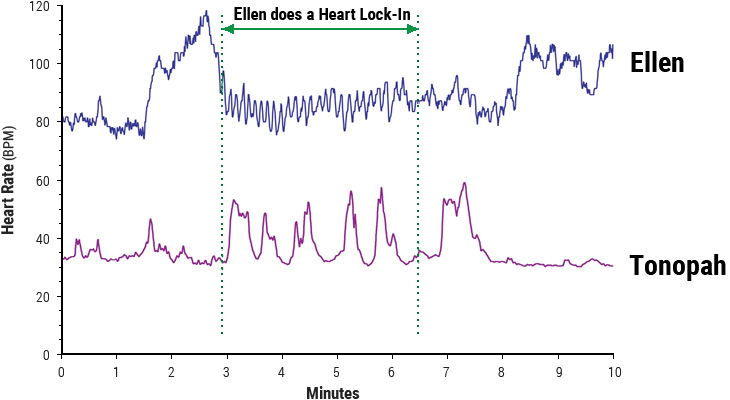
Figure 6.12 Heart-rhythm patterns of woman and horse. These data were obtained using ambulatory ECG recorders fitted on both Ellen and her horse, Tonopah. When she did a Heart Lock-In, her heart rhythms became more coherent and this change appears to have influenced the horse’s heart rhythms.

